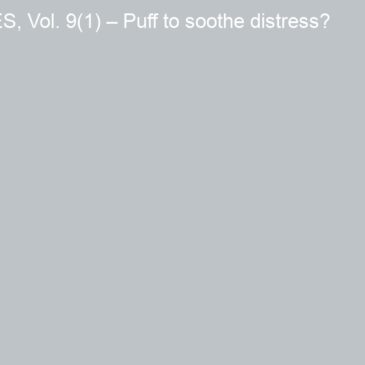Posttraumatic Stress Disorder (PTSD) is a complex anxiety disorder that presents a wide variety of symptoms. Previous studies have found a positive relationship between PTSD and smoking (e. g. Feldner et al., 2007). This week’s ASHES reviews a study that delves deeper into that association, examining how specific PTSD symptom clusters relate to markers of smoking and nicotine dependence (Greenberg et al., 2012).
Methods
- Researchers used data from Waves I and II of the National Epidemiologic Survey on Alcohol and Related Conditions (NESARC), a US-representative general household survey that assessed criteria for mental health disorders (Wave I n=43,093, Wave II n=34,653, Grant, Hasin, Chou, Stinson, & Dawson, 2004).
- The cohort for the present study (n=23,635) had complete PTSD and smoking data, and had experienced at least 1 traumatic event that resulted in feelings of fear, helplessness, or horror.
- The primary instrument used in NESARC, the Alcohol Use Disorders and Associated Disabilities Interview Schedule-DSM-IV version (AUDADIS-IV, Grant et al., 2003), assessed PTSD, smoking behavior, and nicotine dependence.
- Predictors: The researchers used factor analysis to categorize PTSD symptoms into four separate, but correlated, symptom clusters: Re-experiencing (RE), Avoidance (AV), Emotional Numbing (EN), and Hyperarousal (HA). In the analyses that follow, the predictors were symptom counts within each cluster Outcomes: Lifetime smoking status (i.e., whether respondents had smoked over 100 cigarettes in their lifetime); Lifetime nicotine dependence (based on lifetime DSM-IV criteria) The researchers conducted logistic regression analyses predicting smoking outcomes from PTSD symptom clusters. Each regression model was adjusted for demographics, substance use disorder, mania, depression, and anxiety disorder.
Results
- All four PTSD symptom clusters, as well as PTSD diagnosis (i.e., whether the respondent qualified for PTSD) demonstrated significant bivariate associations (not shown) with smoking status and nicotine dependence.
- As Table 1 shows, in logistic regression models that included all four symptom clusters, only EN retained a significant relationship with smoking status, and only HA retained a significant
relationship with nicotine dependence.
| PTSD Symptom Cluster (count of symptoms in each cluster) |
Smoking Status (OR) (N=23,653) | Nicotine Dependence (OR) (N=10,771) |
| Re-experiencing (RE) | 1.12 | 1.11 |
| Avoidance (AV) | 1.14 | 1.11 |
| Emotional Numbing (EN) | 1.30* | 1.08 |
| Hyperarousal (HA) | 0.98 | 1.51** |
Figure. Odds ratios (ORs) for unique associations between PTSD symptom clusters and smoking attributes (Adapted from Greenberg et al., 2012.)
Note. The table includes the results of two logistic regressions, one for each smoking outcome. Both regressions controlled for demographics and other mental health disorders. The sample size for the nicotine dependence model is smaller because only smokers were included. *p <.01; **p < .001
Limitations
- Researchers assessed only lifetime history of PTSD symptoms, smoking status, and nicotine dependence. This limits any temporal or causal inferences we can make about the associations between them.
- The NESARC relies on self-report, which can lead to reporting inaccuracies and biases.
Conclusions
This study finds that when the four different PTSD symptom clusters are entered into the models predicting smoking outcomes, only Emotional Numbing predicts smoking status and only Hyperarousal predicts nicotine dependence. Future research will be needed to explore why individuals who exhibit emotional numbing might be more likely to smoke and why individuals showing signs of hyperarousal are more likely to be addicted to nicotine once they do smoke. Future research in this area might have some practical implications. First, such research might lead to
better efforts to identify individuals at risk for smoking addiction through a detailed examination of PTSD symptomology. Additionally, personalized smoking cessation plans specific to an individual’s specific landscape of PTSD symptom expression could be effective tools for those planning to quit.
–Jed Jeng
Citations
Feldner, M. T., Babson, K. A., Zvolensky, M. J., Vujanovic, A. A., Lewis, S. F., Gibson, L. E., . . .Bernstein, A. (2007). Posttraumatic stress symptoms and smoking to reduce negative affect: An investigation of trauma-exposed daily smokers. Addictive Behaviors, 32(2), 214-227.
Grant, B. F., Dawson, D. A., Stinson, F. S., Chou, S. P., Kay, W., & Pickering, R. (2003). The Alcohol Use Disorder and Associated Disabilities Interview Schedule-IV (AUDADIS-IV): reliability of alcohol consumption, tobacco use, family history of depression and psychiatric diagnostic modules in the general population sample. Drug Alcohol Depend, 71(1), 7-16.
Grant, B. F., Hasin, D., Chou, S. P., Stinson, F. S., & Dawson, D. A. (2004). Nicotine dependence and psychiatric disorders in the United States: Results from the national epidemiologic survey on alcohol and related conditions. Archives of General Psychiatry, 61(11), 1107-1115.
Greenberg, J. B., Ameringer, K. J., Trujillo, M. A., Sun, P., Sussman, S., Brightman, M., . . . Leventhal, A. M. (2012). Associations between posttraumatic stress disorder symptom clusters and cigarette smoking. . Psychology of Addictive Behaviors, 26(1), 89-98.
What do you think? Please use the comment link below to provide feedback on this article.




